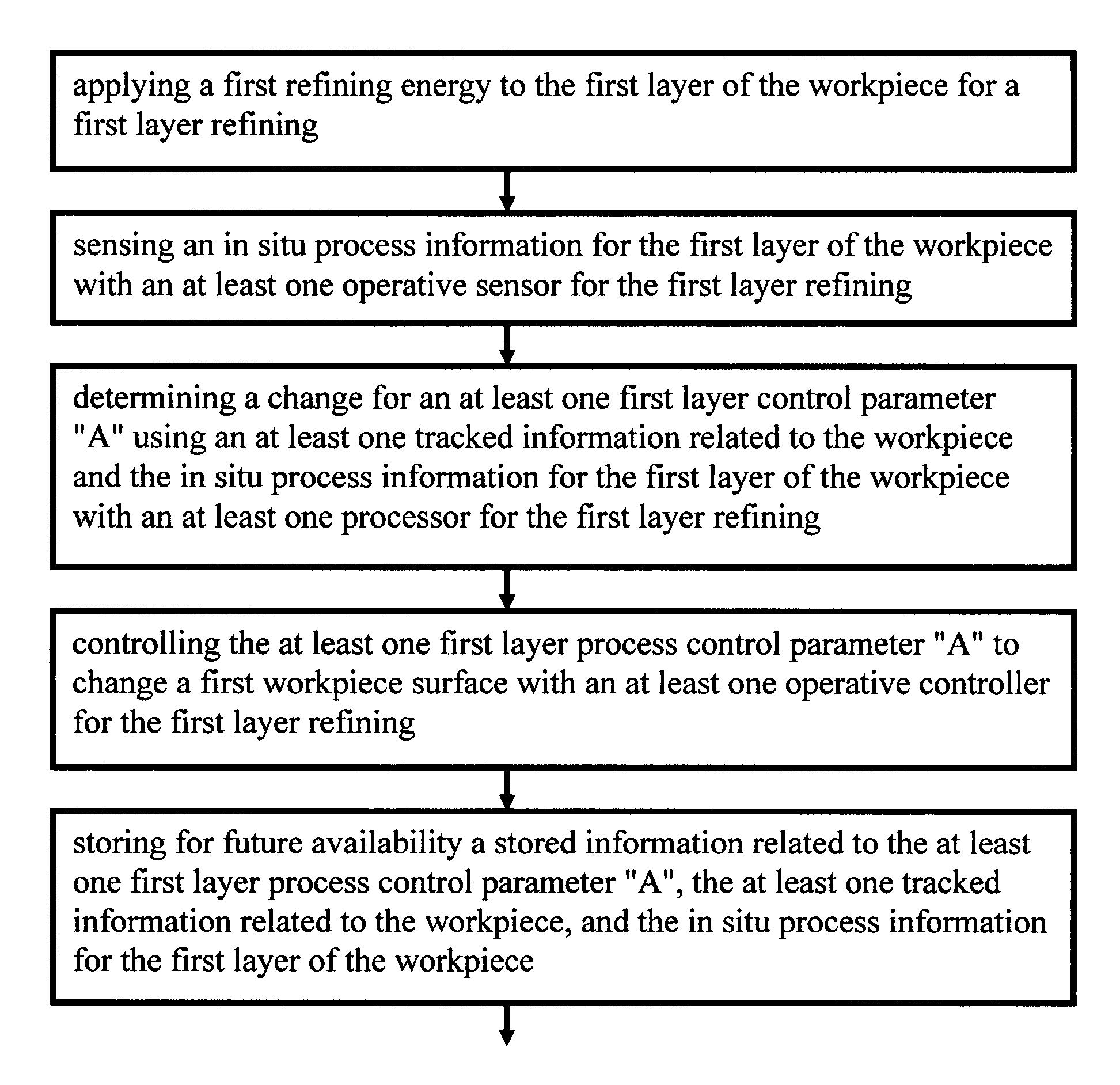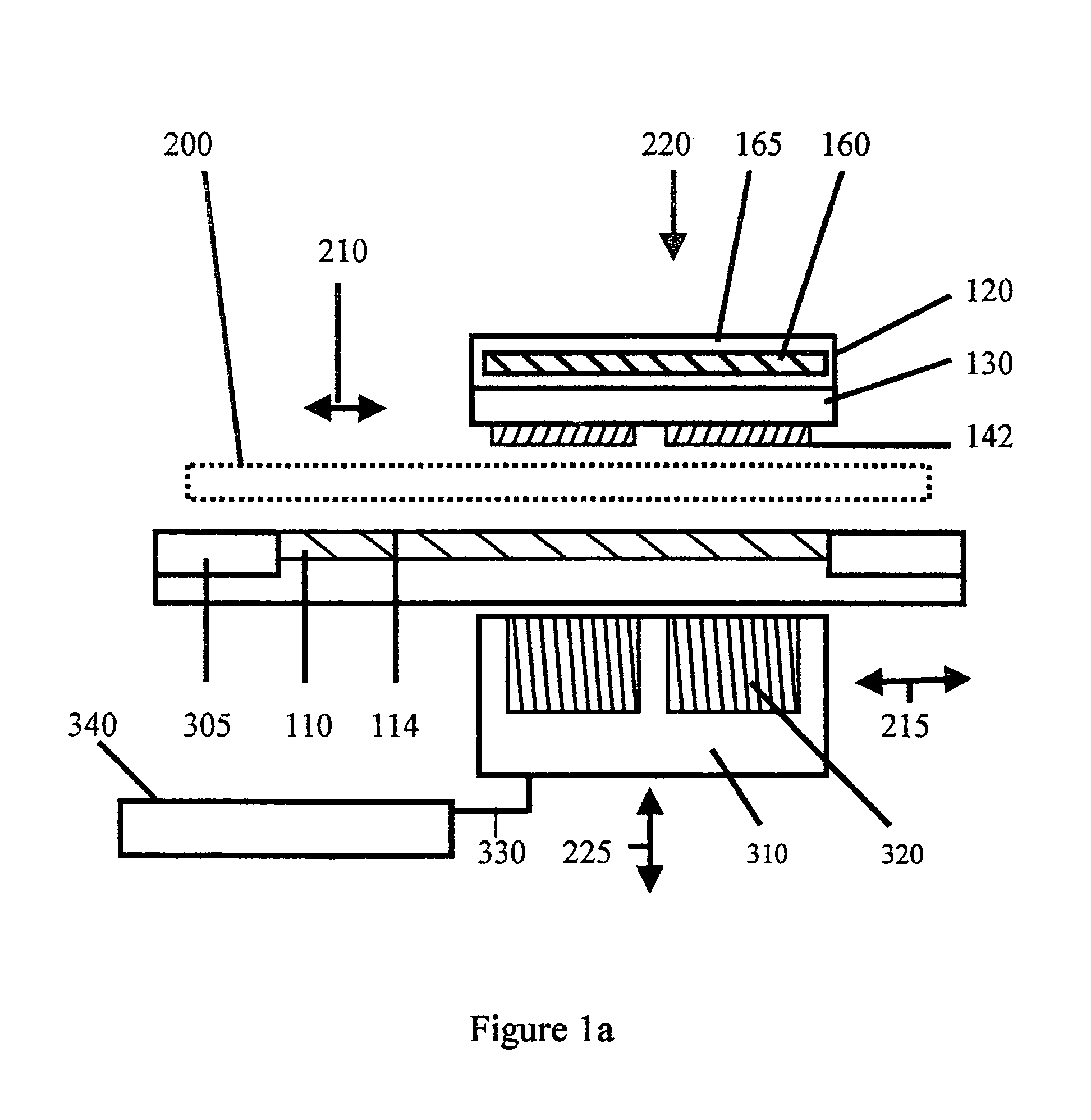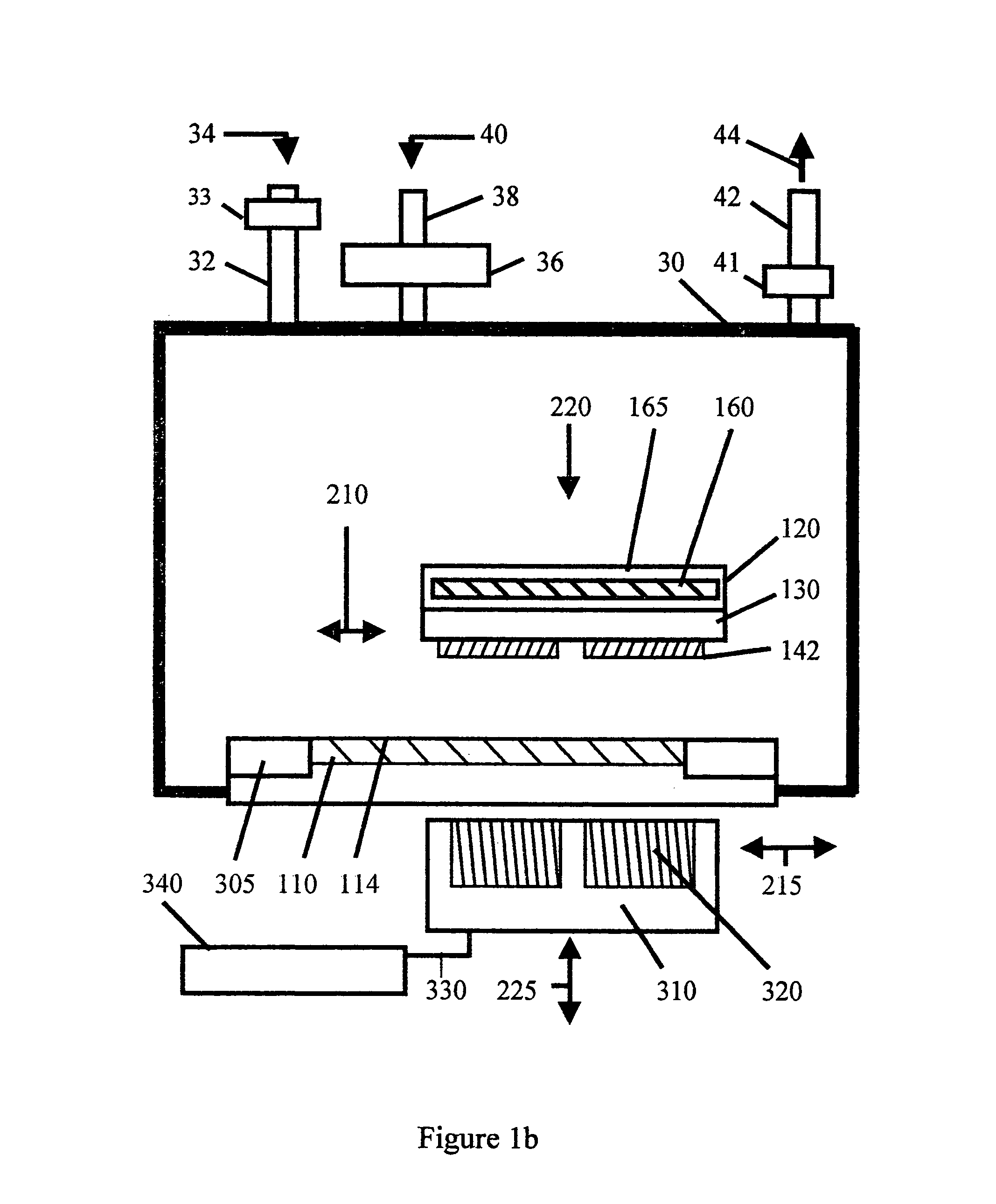[0005]It is an advantage to improve the finishing method for semiconductor wafer surfaces to make them as perfect as possible. It is an advantage to make refining elements and refining equipment with a lower cost of manufacture and reduce the mechanical complexity of the refining equipment and thus also reduce the cost of refining a semiconductor wafer surface or workpiece surface. It is a preferred advantage to develop refining apparatus and refining elements that can be smaller than the workpiece being refined. It is further an advantage to develop refining apparatus that are capable of supplying a parallel refining motion to refining elements solely through magnetic coupling forces. It is further a preferred advantage to develop current finishing apparatus that are capable of supplying multiple different parallel refining motions to multiple different refining elements solely through magnetic coupling forces. It is further a preferred advantage to develop current finishing apparatus that are capable of supplying a plurality of independent parallel refining motions to multiple different refining elements solely through magnetic coupling forces. It is further an advantage to develop current refining apparatus that are capable of supplying multiple different parallel refining motions to multiple different, independently controlled refining elements solely through magnetic coupling forces. It is further an advantage to develop current refining apparatus that are capable of supplying multiple different refining energies, actions, and / or parallel motions to multiple different, independently controlled refining elements. It is further a preferred advantage to develop current refining apparatus, refining elements, and refining capability that can add and remove material from the workpiece surface being refined. It is further a preferred advantage to develop current refining apparatus, refining elements, and refining capability that can add and remove material from the workpiece surface being refined using similar and / or identical drive elements. It is an advantage of the invention to develop a refining element which has a unique way of applying pressure to the unitary and / or a plurality of discrete refining surface(s) and to the workpiece surface being refined. It is an advantage to develop a versatile method to refine a workpiece with two layers. It is an advantage to develop a versatile method use new control methods, quality information, and / or refining rate information to change refining of a workpiece with two layers. It is an advantage to develop a versatile method which uses new control methods, different refining energies, quality information, and / or refining rate information to change refining of a workpiece with two layers and. It is further an advantage to help improve yield and lower the cost of manufacture for finishing of workpieces having extremely close tolerances such as semiconductor wafers. It is further an advantage to help improve versatility and control which will in turn improve yield, reduce consumable costs, and lower the cost of manufacture for refining of workpieces having extremely close tolerances such as semiconductor wafers. Preferred embodiments accomplish one or more of the above advantages with a new structure and function in a new way to give the new and useful result.
[0006]A preferred embodiment is directed, to a method of refining a first and a second layer of a workpiece, each having an effect on a cost of manufacture of the workpiece, the method comprising applying a first refining energy to the first layer of the workpiece for a first layer refining; sensing an in situ process information for the first layer of the workpiece with an at least one operative sensor for the first layer refining; determining a change for an at least one first layer control parameter “A” using an at least one tracked information related to the workpiece and the in situ process information for the first layer of the workpiece with an at least one processor for the first layer refining; controlling the at least one first layer process control parameter “A” to change a first workpiece surface with an at least one operative controller for the first layer refining; storing for future availability a stored information related to the at least one first layer process control parameter “A”, the at least one tracked information related to the workpiece, and the in situ process information for the first layer of the workpiece; applying a second refining energy to the second layer of the workpiece having an at least one second layer control parameter “B” for a second layer refining; sensing an in situ process information for the second layer of the workpiece with an at least one operative sensor for the second layer refining; determining a change for the at least one second layer control parameter “B” using the at least one tracked information related to the workpiece, the in situ process information for the first layer of the workpiece, and the in situ process information for the second layer of the workpiece with an at least one processor for the second layer refining; controlling the at least one second layer process control parameter “B” to change a second workpiece surface with an at least one operative controller for the second layer refining; and using at least in part an at least one process model during the method and wherein the method makes an appreciable change to the cost of manufacture of the workpiece.
[0007]A preferred embodiment is directed to a method of refining a first and a second layer of a workpiece, each having an effect on a cost of manufacture of the workpiece, the method comprising applying a first refining energy to the first layer of the workpiece for a first layer refining; sensing an in situ process information for the first layer of the workpiece with an at least one operative sensor for the first layer refining; determining a change for an at least one first layer control parameter “A” using an at least one tracked information related to the workpiece, an at least one tracked quality information related to the first layer refining, and the in situ process information for the first layer of the workpiece with an at least one processor for the first layer refining; controlling the at least one first layer process control parameter “A” to change a first workpiece surface during the first layer refining of the first layer of the workpiece with an at least one operative controller for the first layer refining; storing for future availability a stored information related to the at least one first layer process control parameter “A”, the at least one tracked information related to the workpiece, the at least one tracked quality information related to the first layer refining, and the in situ process information for the first layer of the workpiece; applying a second refining energy to the second layer of the workpiece having an at least one second layer control parameter “B” for a second layer refining; sensing an in situ process information for the second layer of the workpiece with an at least one operative sensor for the second layer refining; determining a change for the at least one second layer control parameter “B” using the at least one tracked information related to the workpiece, the in situ process information for the first layer of the workpiece, the at least one tracked quality information related to the first layer refining, an at least one tracked quality information related to the second layer refining, and the in situ process information for the second layer of the workpiece with an at least one processor for the second layer refining; controlling the at least one second layer process control parameter “B” to change a second workpiece surface during the second layer refining of the second layer of the workpiece with an at least one operative controller for the second layer refining; and using at least in part an at least one process model during the method and wherein the method makes an appreciable change to the cost of manufacture of the workpiece.
[0008]A preferred embodiment is directed to a method of refining a first and a second layer of a workpiece, each having an effect on a cost of manufacture of the workpiece, the method comprising applying a first refining energy to the first layer of the workpiece for a first layer refining; sensing an in situ process information for the first layer of the workpiece with an at least one operative sensor for the first layer refining; determining a change for an at least one first layer control parameter “A” using an at least one tracked information related to the workpiece, an at least one tracked refining rate information related to the first layer refining, and the in situ process information for the first layer of the workpiece with an at least one processor for the first layer refining; controlling the at least one first layer process control parameter “A” to change a first workpiece surface during the first layer refining of the first layer of the workpiece with an at least one operative controller for the first layer refining; storing for future availability a stored information related to the at least one first layer process control parameter “A”, the at least one tracked information related to the workpiece, the at least one tracked refining rate information related to the first layer refining, and the in situ process information for the first layer of the workpiece; applying a second refining energy to the second layer of the workpiece having an at least one second layer control parameter “B” for a second layer refining; sensing an in situ process information for the second layer of the workpiece with an at least one operative sensor for the second layer refining; determining a change for the at least one second layer control parameter “B” using the at least one tracked information related to the workpiece, the in situ process information for the first layer of the workpiece, the at least one tracked refining rate information related to the first layer refining, an at least one tracked refining rate information related to the second layer refining, and the in situ process information for the second layer of the workpiece with an at least one processor for the second layer refining; controlling the at least one second layer process control parameter “B” to change a second workpiece surface during the second layer refining of the second layer of the workpiece with an at least one operative controller for the second layer refining; and using at least in part an at least one process model during the method and wherein the method makes an appreciable change to the cost of manufacture of the workpiece.
[0009]A preferred embodiment is directed to a method of refining a first and a second layer of a workpiece, each having an effect on a cost of manufacture of the workpiece, the method comprising applying a first refining process to the first layer of the workpiece for a first layer refining; sensing an in situ process information for the first layer of the workpiece with an at least one operative sensor for the first layer refining; determining a change for an at least one first layer control parameter “A” using an at least one tracked information related to the workpiece, an at least one tracked refining rate information related to the first layer refining, an at least one tracked quality information related to the first layer refining, and the in situ process information for the first layer of the workpiece with an at least one processor for the first layer refining; controlling the at least one first layer process control parameter “A” to change a first workpiece surface during the first layer refining of the first layer of the workpiece with an at least one operative controller for the first layer refining; storing for future availability a stored information related to the at least one first layer process control parameter “A”, the at least one tracked information related to the workpiece, the at least one tracked refining rate information related to the first layer refining, the at least one tracked quality information related to the first layer refining, and the in situ process information for the first layer of the workpiece; applying a second refining process to the second layer of the workpiece having an at least one second layer control parameter “B” for a second layer refining; sensing an in situ process information for the second layer of the workpiece with an at least one operative sensor for the second layer refining; determining a change for the at least one second layer control parameter “B” using the at least one tracked information related to the workpiece, the in situ process information for the first layer of the workpiece, the at least one tracked refining rate information related to the first layer refining, the at least one tracked quality information related to the first layer refining, an at least one tracked refining rate information related to the second layer refining, an at least one tracked quality information related to the second layer refining, and the in situ process information for the second layer of the workpiece with an at least one processor for the second layer refining; controlling the at least one second layer process control parameter “B” to change a second workpiece surface during the second layer refining of the second layer of the workpiece with an at least one operative controller for the second layer refining; and using at least in part an at least one process model during the method and wherein the method makes an appreciable change to the cost of manufacture of the workpiece.
[0010]One or more of these advantages are found in the embodiments of this invention. Illustrative preferred advantages can include higher profits and / or controlled costs during refining of a workpiece. Illustrative preferred advantages can include one or more improvements in quality. Illustrative preferred advantages can include one or more improvements in refining rate. Illustrative preferred advantages can include an appreciable change to the cost of manufacture or profitability. These and other advantages of the invention will become readily apparent to those of ordinary skill in the art after reading the following disclosure of the invention. Other preferred embodiments are discussed herein.BRIEF DESCRIPTION OF SEVERAL VIEWS OF THE DRAWINGS
 Login to view more
Login to view more 


